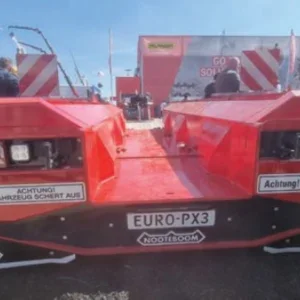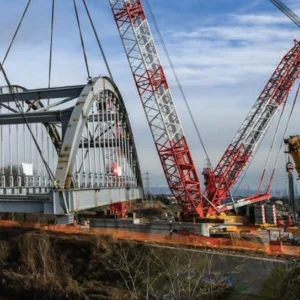Safety features are among the top priorities for Swedish radio remote control manufacturer Datek. In launching its latest product, a set of cabin control units to complement its line of portable transmitters, it stressed the appeal of having “[cabin] controllers to fulfill the same high safety standards as regular radio remote control systems, something you don’t obtain when just installing a couple of regular joysticks.”
A spokesperson for Datek says the company has just developed an angle, free-fall and shock detection feature option for its MIDI transmitter series: “Should the operator drop the transmitter or fall over, this immediately triggers a stop function and the controlled plant ceases operation. The protection device senses a fall or if the transmitter is positioned at an unnatural angle.”
The spokesperson says competition in the radio remote control sector is strong, but that European producers have tended to focus on particular national markets: “We have a strong grip of the Scandinavian market since we have been present here since 1979 and have built up a good relationship with the customers over the years. The situation is similar for the other producers in their countries and regions, so even though the completion is fierce overall, we still have our geographical regions that are protected thanks to loyal customers.”
Some of the geographic strongholds, according to Datek, see Sweden dominated by Åkerströms, Datek, Tele-Radio and Scanreco; Germany mainly by HBC, Hetronic and NBB; Italy by Autec, Imet and Elca; Spain by Ikuzi and Itowa; Norway by Microcontrol/Cavotec; and France by Jay.
One company expanding its operations is Cavotec. The company has a strong global presence. It acknowledges that “the current tough economic environment puts added pressure on the already crowded, and often niche radio remote control market”, but says there are still opportunities.
“We see interest gradually picking up in Australia, Europe, India, and Scandinavia”, says Cavotec Microcontrol sales manager Morten Bjerkholt.
Last year, Cavotec delivered the first remote control system for use on a land-based oilrig in the Middle East. The MC-3300 unit will be used on a National Oilwell Varco rig, currently being built in the Jebel Ali Free Zone in Dubai.
The MC-3300 is a remote control terminal designed to perform several applications simultaneously. Twin battery slots allow operators to change batteries while continuing to use the system, reducing downtime. The system is designed to operate any direct hydraulic and electric control function and provide serial communication with most known PLC and frequency converters. The MC-3300’s housing exceeds ingress protection norm IP66/67 and is constructed from special impact and chemical resistant plastic.
Italian manufacturer Autec’s sales and marketing director Domenico Didonè says they are accustomed to the strong competition: “the implication is that you have to be better than your competitors”.
The company says all of its systems have integrated safety functions: “The systems we offer are fully tested at component and system level before leaving the company. Our main product lines are certified for functional safety by TÜV Suddeutschland,” says Didonè.
HBC-radiomatic says that it aims to develop systems “that exceed any legal safety standards by far”. For example, HBC-radiomatic recently presented new safety features that enable an automatic shutdown of the radio control in specific emergency situations. The company says the integrated LCDs available on its systems “significantly increase safety by clearly displaying key information, such as crane load weight or wind speed.”
Displays
Improvements in displays are at the forefront in terms of demand from users, and consequently are a feature manufacturers are striving to improve.
A HBC-radiomatic spokesman says, “The latest developments by HBC-radiomatic allow the clear indication of system-related information like battery status or signal strength and of virtually unlimited feedback information, such as wind speed warnings, error messages and much more. To meet the specific needs of the customers, HBC displays can be 100% customised.”
HBC-radiomatic is working on various projects with the devices, including a recent joint project with Liebherr to introduce a new series of radio controls for construction cranes of the MK, K and EC-H Litronic series. A choice of transmitters (Spectrum A or Spectrum B) is used, depending on the size of crane. Both products have an integrated display, which makes information about the load and status of the crane available to the user just as it would be seen when controlling the crane from the cabin. HBC-radiomatic says this makes operating the crane safer and more convenient. Overhang tables on the booms are no longer necessary because all information is easily visible on the display.
The new radio controls have been updated from existing models; the engineers designed and programmed a customised display completely according to Liebherr specifications.
HBC-radiomatic expects future display development will mainly focus on devices with a higher resolution and improved graphics, thus opening up a wider range of applications.
According to Didonè at Autec, an area gaining “more and more interest” is pushbutton and joystick systems with displays. “Vision has to be clear and effective; we use standard and old technology to reach a high level of contrast and clear view in daylight and save energy; customers can choose the data that is displayed. Commonly this would include: weight from load cells, wind speed from anemometers, oil pressure from hydraulic circuits, alarms,” he says.
Datek released its graphic display in 2004. It can show pictures and text in a flexible manner. The field bus technology (serial communication) has made it possible to send an increasing amount of data to the display. For example, the systems can have up to 65,536 different text messages in plain text displayed to the operator, each consisting of up to 160 characters.
Tele Radio’s newly developed 860-Lion joystick transmitter, along with its Tiger transmitter, also includes a display. The display shows frequency and channel among other information needed when making choices and adjustments. Its new platform allows a greater level of customisation, with options such as duplex functions and GSM.
In September last year, Cavotec launched new versions of its hand-held, push-button radio remote controls, the MC-2-3 and MC-2-5. Designed for use in the most severe and demanding of industrial and climatic environments, the ergonomic and weatherproof units improve on existing models with functions such as a superior interface with an easily readable rear-lit display.
“Both the MC-2-3, and the MC-2-5 constantly update system status, and can, for example, show exactly how much torque and load the equipment is carrying at any given time, providing users with a wide safety margin,” says Bjerkholt.
Both systems run on standard AA batteries, and use the ISM band at 434MHz. The accompanying base unit, MC–IRX–Lite, operates on 85–260VAC and 10–30VDC supply. The terminal and base unit comprise one general purpose 0–10VDC feedback channel to show equipment parameters.
The right wavelength
Out of the challenges for manufacturers of crane remote controls, much attention is being paid to radio frequencies.
Itowa has focused much work on the technology in order that its radio remote controls can offer greater reliability in the radio frequency bands. It recently introduced a bi-directional remote control that returns the information back to the transmitter, facilitating communication between the worker and the receiver.
A spokesperson for Itowa says, “The great quantity of radio remote controls existing in different fields has made it more difficult to work on the radio frequency world: the technology has to be advanced to avoid interference and the collapse of frequency bands.”
The company has introduced GCFI technology (Intelligent Changing Frequency Management) which can be introduced in most products to avoid interference. The radio remote controls detect the occupied frequencies and the technology ensures the channels are not used.
Interference is also cited as a major issue by Autec. In its Modular Series systems it has implemented similar functions, which it calls ACS (Automatic Channel Search). It performs an automatic search of the working frequency; if interference is detected in the work area while working with the radio remote control, radio communication moves automatically to a free channel, while the radio link is maintained and operation is not interrupted. Similarly, it works without requiring operator action, so the operator does not need to remember the correct sequence to use to change frequency.
Didonè says Autec’s future developments in remote controls would focus on user demands and to fit new applications. He says users are asking that all the existing controls of the machine be included in the portable transmitter, “which at the same time should be as light as possible and ergonomic; size is very important and small is not always best: big hands, industrial gloves, and many actuators demand a clean layout of the control panel”.
For HBC-radiomatic, its modular flexcard system is the core of a new generation of HBC radiobus receivers. It is a receiver kit based on various plug-in cards (flexcards) with specific functions. Depending on the needs of the customer, only applicable plug-in cards have to be inserted into the receiver to allow customisation of the radio control. In case of a defective radio system, the operator needs only to exchange the respective flexcard and work can continue.
Product development
There have been several other remote control products released recently. Datek’s new cabin control units, which the company claims are unique in having both fixed and portable controllers for cranes, can either be used by themselves or together with a radio transmitter in order to provide the operator freedom of choice from where to control the crane.
The cabin controllers were designed to be easy to install and they communicate either by a serial interface using two wires or by radio with the receiver unit.
The receiver units are available in different versions supporting CAN-bus, Profibus, RS232 as well as digital relay outputs. The controllers fulfill the same safety standards as regular radio remote control systems, which is not obtainable when installing regular joysticks.
In addition to Tele Radio’s models, mentioned earlier, the manufacturer has recently launched its Lynx model radio remote control system with duplex functions. Developed for applications where there is a requirement of feedback from the equipment, both hand unit and the stationary unit use a ”two way communication” technique with visible feedback on the transmitter’s LEDs.
Ikusi used Intermat 2009 to launch its TM70 range of radio remote control systems for tower cranes, hydraulic cranes and mobile machinery. The LCD70 display option is also available in all the models, providing feedback information from the receiver to the transmitter’s display.
Its accompanying new software will make it possible to adjust remotely (Tele-alignment option) the receiver’s analogue card parameters (start/stop/type of response/PWM frequency/dither if required, etc) in order to adapt on site the machine’s response, providing more accurate and soft control of the machine.
Ikusi also announced at Intermat its new “tiny” CAN receiver, providing several communication protocols, like CANopen standard CIA DS 401, IQAN, SAE J1939, focused to mobile machinery applications. The receiver can be combined with all the TM70 transmitter models.






